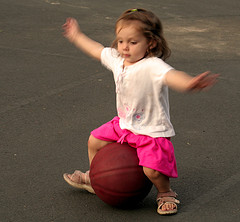Our balance depends on three main sensory areas: the vestibular system, the proprioceptive system, and the visual system.
With age, and with certain neurologic conditions, one or more of these areas can become compromised. People can often compensate when one of them is damaged. But when two or more are impaired, people can be at a greatly increased risk of falling.
David J. Thurman M.D., M.P.H
I didn’t feel particularly unstable riding in my saddle on Twistur at a walk, but I had my eyes open and wasn’t standing on one leg.
Strength and flexibility
My difficulty balancing on one leg is partly due to my leg and foot strength being unable to hold me when I start to tip. I watched a yoga instructor doing the one leg pose of Warrior III. Her foot and body muscles were working on small corrections to maintain her balance.
An important component of maintaining good balance is strength and coordination in the lower extremities. This frequently declines as we get older. As a result, our ability to react quickly to a change in posture is diminished.
David J. Thurman, M.D., M.P.H is an author of guidelines on recognizing fall risk for the American Academy of Neurology (AAN).
Vision
Balance can improve by consciously adjusting the body’s position based on vision. Closing the eyes removes this method of balancing.
Proprioception
Proprioception is the ability to identify the body’s position in space through special sensory stimuli. The sobriety test of closing the eyes and touching the nose is a test of proprioception. Where is your hand? Where is your nose? There are special sensors in the joints, muscles, and tendons that detect changes in your body’s movement and position. There are reflexes that compensate by responding to pressure on the joints and muscles to maintain posture. A person standing upright begins to lean to one side and the muscles reflexively contract to maintain balance.
Vestibular function
Vestibular balance comes from the inner ear that can detect body positional tilt and movement. Your vestibular system works together with your eyes in the vestibulo-ocular reflex to help keep images properly centered on your retina. When the head turns one way, then the eyes turn the other way to hold the image steady. The vestibular system can affect posture via a reflexive pathway. For instance a perceived forward motion causes a sway forward to maintain the support base. Various medications and high blood pressure can cause damage to the inner ear. Age is the biggest risk factor for vestibular disorders. Sometimes the body gets improper signals. Vertigo results from a mismatch of vestibular, ocular, and proprioceptive inputs.
The body needs input from the eyes, the feet, and ears (including the vestibular system) to stay upright. All of these systems decline during the natural course of aging, which can lead to balance problems.
Yuri Agrawal, M.D., an otolaryngologist at Johns Hopkins Medicine
There are several different balance tests. I wish there was a test to help me determine my likelihood of falling off my horse. I don’t want to take the test of “Horse sees scary monster, spins and takes off test”. That probably would be a test that I’d fail.
What I need to improve
One thing I do know is that I need to keep my eyes open! I rely strongly on my visual system for my balance. Closing my eyes makes me much more unstable standing on one leg, but I can walk down a dark hallway at night without much difficulty. I can tell when I am starting to tip over and where my body parts are located. With practice I can improve strength in my feet, ankles and core muscles that should help with standing on one leg and also general balance.
The preponderance of evidence shows fairly convincingly that strength and balance training can reduce the rate of falls by up to about 50 percent.
Dr. Thurman
How to get better balance?
There are many different exercises to work on the various methods the body uses to balance. This is good news for improving balance for riding too. Improvements in balance progresses in increments and may take as long as 3 months to notice a change. Professor Tracey Howe, of Glasgow Caledonian University whose findings are published in The Cochrane Library says to improve balance you should exercise at least 3 times a week and “combine activities, such as carrying things while walking or dancing which involves using various parts of the body.”
References:
(1) Neurology Now (American Academy of Neurology) April/May 2011 Volume 7(2) p 32–33 by Shaw, Gina
(2): From “The New York Times” article “Staying on Balance, With the Help of Exercises” by John Hanc Published: 09/15/2010
Tests:
Romberg Test, Clinical Balance Function Test, Berg Balance Test, Tinetti, Fullerton Advanced, Spring Scale, Y Balance Test.






